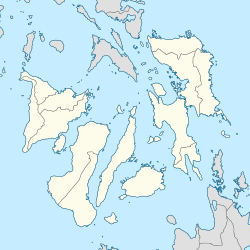
Summary
The Santa Barbara Parish Church and Convent (Spanish: Iglesia y Convento de Santa Bárbara) is a Roman Catholic church located in the municipality of Santa Barbara, Iloilo, Philippines, under the Archdiocese of Jaro. The church is considered to be the "Cradle of Independence" in Panay and in the Visayas.
| Santa Barbara Church | |
|---|---|
| |
 Church façade and convent in 2022 | |
 Santa Barbara Church  Santa Barbara Church | |
| 10°49′40″N 122°31′55″E / 10.827678°N 122.532075°E | |
| Location | Santa Barbara, Iloilo |
| Country | Philippines |
| Denomination | Roman Catholic |
| History | |
| Status | Parish church |
| Founded | 1760 |
| Founder(s) | Fr. Juan Ferrer |
| Dedication | St. Barbara |
| Events | First Cry of Revolution against Spain outside Luzon |
| Architecture | |
| Functional status | Under restoration |
| Heritage designation | National Historical Landmark |
| Designated | 1991 |
| Architectural type | Church building |
| Specifications | |
| Materials | Bricks |
| Administration | |
| Province | Jaro |
| Archdiocese | Jaro |
| Clergy | |
| Archbishop | Jose Romeo Lazo |
| Priest(s) | Rt. Rev. Msgr. Sergio U. Jamoyot, H.P. |
| Assistant priest(s) | Rev. Fr. Eric John Vargas |
History edit
In 1760, the settlement near the Tigum and Aganan rivers became a Pueblo, and the church became an independent parish. Saint Barbara was assigned to be the symbol of the parish, which was headed by parish priest Father Juan Ferrer. The construction of the Augustinian church that would last to the present day began when Father Francisco Aguerria arrived in 1845. Construction of the road networks that would connect the parish to Cabatuan, Maasin, Janiuay, Leon, and Alimodian also started at the same time.
The funds for the church construction would be sourced out from the taxes of the parishioners that costs between 8 and 12 reales (between ₱1.00 and ₱1.50). Wealthier people escaped labor by paying larger amounts.
Under the laws of Repartamiento, men over 16 years of age were required to engage in 40 days of forced labor doing works on Spanish-owned farms and public works. Laborers from distant towns contributed to the construction of the church. Sketches of the plans and design of the church were drawn on the walls and columns of the church which was believed to not possess any formal plans for its buildability.[1]
Workers labored over both the quarried stones and mulawon and mangle wood-types that both came from the municipalities of Leon, Alimodian and Tubungan.
In 1991, the National Historical Commission of the Philippines declared Santa Barbara Church and Convent as a National Landmark. The church was the site where General Martin Delgado of the Visayan Revolutionary Government started the junta that resulted to the first Cry of Revolution against the Spaniards outside Luzon.[2][3] It was also used as the general headquarters and military hospital of the revolutionary forces.[3]
The National Museum declared Santa Barbara Church as a national cultural treasure in 2013. A historical marker was unveiled in December 2015.[4][5]
Architecture edit
The overall style of the church can be viewed as neoclassical with the unembellished front facade. Dividing the front facade plane are four sets of Tuscan pilasters. The central division contains the main entrance while the end divisions contain two niches accommodating the Blessed Virgin and Sacred Heart of Jesus icons.
Three stained glass windows puncture the facade of the upper level. This fenestration indicates a choir loft located inside. The side windows are capped with crests of the Pope (on the left) and the Augustinians (on the right). On the uppermost part of the front facade is a niche which contains a statue of St. Barbara.[1]
Restoration edit
Santa Barbara Church and Convent was restored for the celebration of the Philippine Independence Day in 2015. President Benigno Aquino III celebrated the national event in Santa Barbara, Iloilo. The National Historic Commission of the Philippines supervised the restoration of the historic church and convent.[2]
-
Original facade before restoration
-
Restoration on the facade
References edit
- ^ a b Ducharme, Fergus. "The Church of Sta Barbara, Santa Barbara, Iloilo, the Historic Cradle of Independence in the Visayas". Historic Old Philippines. Retrieved October 26, 2014.
- ^ a b c Lujan, Nerio (August 1, 2013). "Santa Barbara Church and Convent Restoration". Official Website of the Province of Iloilo. Province of Iloilo Government. Retrieved October 26, 2014.
- ^ a b Cordero, Zoila (January 22, 2014). "Restoration of Santa Barbara Catholic Church & Convent". Official Website of Santa Barbara, Iloilo. Retrieved October 26, 2014.
- ^ "Sta. Barbara Church nat'l cultural treasure marker unveiled". Iloilo Metropolitan Times. Retrieved December 26, 2015.
- ^ "Santa Barbara Church added to Iloilo's Cultural Treasures". Manila Times. Retrieved December 26, 2015.
External links edit
- Media related to Santa Barbara Church (Santa Barbara, Iloilo) at Wikimedia Commons
- Santa Barbara Church, Santa Barbara, Iloilo on Facebook


